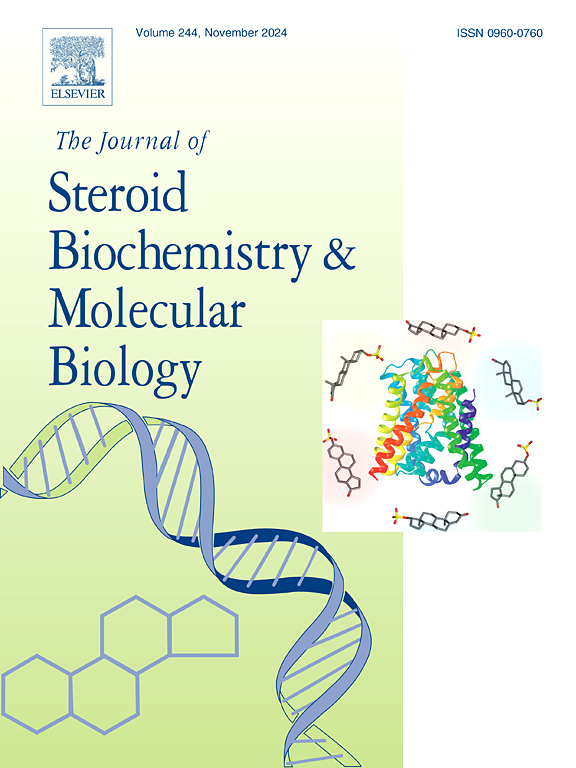7-Ketocholesterol: A pathogenic oxysterol in atherosclerosis and lysosomal storage disorders – Molecular insights and clinical implications
IF 2.5
2区 生物学
Q3 BIOCHEMISTRY & MOLECULAR BIOLOGY
Journal of Steroid Biochemistry and Molecular Biology
Pub Date : 2025-05-30
DOI:10.1016/j.jsbmb.2025.106797
引用次数: 0
Abstract
One important oxysterol produced by the autoxidation of cholesterol is 7-Ketocholesterol (7-KC), which plays a major role in both physiological and pathological processes. The pathogenic functions of 7-KC are reviewed in this study, with particular attention paid to its molecular processes and its participation in a number of diseases, such as lysosomal storage disorders (LSDs) and atherosclerosis. Through processes like oxidative stress, phospholipidosis, and lysosomal accumulation, 7-KC causes cytotoxicity, which in turn results in cell death. In atherosclerosis, it has a role in plaque instability, foam cell production, and endothelial dysfunction. Furthermore, 7-KC intensifies lysosomal dysfunction in LSDs, hastening the course of the illness. Additionally, 7-KC causes oxiapoptophagy, a kind of cell death marked by the co-occurrence of autophagy, apoptosis, and oxidative stress. By influencing inflammatory signalling, Reactive oxygen species (ROS) generation, and lipid peroxidation, 7-KC increases cellular damage and speeds up the aetiology of disease. This study clarifies how 7-KC contributes to endothelial dysfunction, atherosclerosis, and LSDs by highlighting its dual roles as a pathogenic molecule and a possible therapeutic target.
酮胆固醇:动脉粥样硬化和溶酶体贮积障碍中的一种致病性氧甾醇-分子见解和临床意义
7-酮胆固醇(7-KC)是由胆固醇自氧化产生的一种重要的氧甾醇,它在生理和病理过程中都起着重要作用。本研究综述了7-KC的致病功能,特别关注其分子过程及其参与的一些疾病,如溶酶体储存障碍(lsd)和动脉粥样硬化。通过氧化应激、磷脂病和溶酶体积累等过程,7-KC引起细胞毒性,进而导致细胞死亡。在动脉粥样硬化中,它在斑块不稳定、泡沫细胞产生和内皮功能障碍中起作用。此外,7-KC加剧了lsd的溶酶体功能障碍,加速了疾病的进程。此外,7-KC引起细胞凋亡,这是一种自噬、细胞凋亡和氧化应激共同发生的细胞死亡。通过影响炎症信号、活性氧(ROS)的产生和脂质过氧化,7-KC增加了细胞损伤并加速了疾病的病因。本研究通过强调7-KC作为致病分子和可能的治疗靶点的双重作用,阐明了7-KC如何参与内皮功能障碍、动脉粥样硬化和lsd。
本文章由计算机程序翻译,如有差异,请以英文原文为准。
求助全文
约1分钟内获得全文
求助全文
来源期刊
CiteScore
8.60
自引率
2.40%
发文量
113
审稿时长
46 days
期刊介绍:
The Journal of Steroid Biochemistry and Molecular Biology is devoted to new experimental and theoretical developments in areas related to steroids including vitamin D, lipids and their metabolomics. The Journal publishes a variety of contributions, including original articles, general and focused reviews, and rapid communications (brief articles of particular interest and clear novelty). Selected cutting-edge topics will be addressed in Special Issues managed by Guest Editors. Special Issues will contain both commissioned reviews and original research papers to provide comprehensive coverage of specific topics, and all submissions will undergo rigorous peer-review prior to publication.

 求助内容:
求助内容: 应助结果提醒方式:
应助结果提醒方式:


